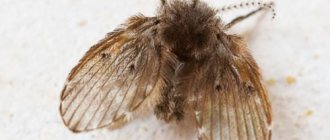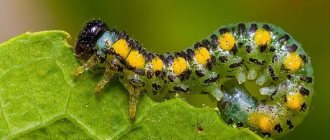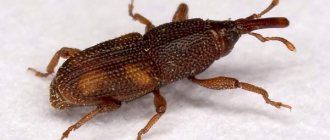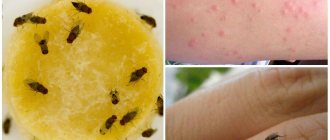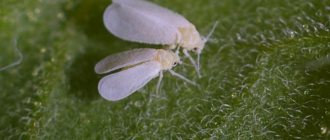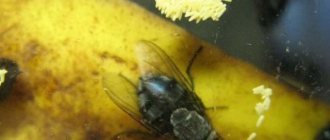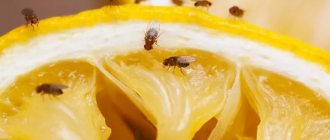10.07.2019
Sometimes even the cleanest owner of an apartment or house can have small black bugs in her cereals and flour. If measures are not taken to get rid of pests in a timely manner, they can become a serious problem. Let's look at how to permanently destroy uninvited guests.
- What types of bugs are found?
- Causes of insects in the kitchen
- Where do pests most often occur?
- How dangerous are cereals with bugs?
- 7 most effective pest control products
- Note to housewives
What types of bugs are found?
Tiny pests can live in the kitchen:
- Surinamese mucoeds.
Suriname mucoed
These exotically named beetles love cereals and thrive in them. Females of these insects often breed in warehouses. Tiny eggs cannot be seen by humans with the naked eye. Adult beetles and larvae can enter living spaces in bags of bulk foods such as cereals, pasta and rice. However, the Surinamese flour eater (its maximum length is 2 millimeters) loves not only cereals. It can spoil nuts, crackers, concentrates, dried fruits, dried fruits, and cookies.
- Flour beetle. This is the name given to a small beetle with a maximum body length of 4 millimeters. These insects in the kitchen settle in bags containing cereals, kitchen containers for bread, and cabinets.
flour beetle
They have an orange color, which is clearly visible on light-colored surfaces. They feed on flour from wheat and rye, as well as semolina, rice and other cereals.
- Grinder. These parasites, often found in the kitchen, have oval-shaped heads. The maximum length is 3 millimeters. These insects in cereals have a color ranging from dark yellow to brown. They easily gnaw their way through floors, doors, and window sills. Found in flour, cereals, they also love nuts, dried fruits, and cookies. In addition, they often eat wood, sweets, and pasta.
Grinder
- Food moth. This pest also often lives in flour. It does not belong to beetles, but to Lepidoptera, essentially being a tiny butterfly.
food moth
The best way to deal with bugs in the kitchen
So, how to get bugs out of cereals in the kitchen? There is nothing better than good old Dichlorvos.
The disgusting thing is, of course, rare, but it kills bugs on the spot. But before you treat the surfaces, find a place where you can then sit for at least half a day so that it can air out.
The procedure in this case is as follows:
- 1. Go through everything you can and take it outside (or another room)
- 2. Wipe cabinets, floors, baseboards with a damp cloth
- 3. Wash dishes and jars for cereals and pour boiling water over them (to kill the larvae)
- 4. Treat everything with Dichlorvos (necessarily wearing a mask and glasses) and retreat to visit someone
We do not advise you to call all sorts of companies that guarantee disinfection. They haven’t invented anything new, but it costs a lot of money.
No, if you have extra funds, then you can call so as not to breathe in the chemicals yourself. But, if we talk about efficiency, then there is no difference: you carry out the treatment yourself or pay people, no matter what they say, that eradicating it at home is unrealistic.
Causes of insects in the kitchen
Why do such pests appear in cereals? They strive to live in places where there is a sufficient amount of food, in particular, access to bread products and cereals is provided.
Bags that do not close tightly enough and contain flour and cereals, rice or semolina, after being scattered on the shelves, become attractive to mealworms, grinders, and flour eaters.
A large amount of pasta and cereals also attracts food moths. Parasites often spoil products such as cookies, crackers, dried fruits, nuts, concentrates and bread. House grinders settle in places where there is a large amount of dried wood, and there are food supplies nearby. For this reason, harmful insects often live in kitchens.
Intensive reproduction of parasites in cereals leads to their colonization, in addition to the kitchen, also in other rooms of the apartment or private house - a pantry, a room in which homeowners can sometimes eat while watching TV. Bugs are sometimes found, in addition to bags of cereals and bread bins, also in textiles and furniture.
If you are concerned about the question of how to remove such insects, first of all you should realize that if you have food in the kitchen, they can always appear, even if you maintain perfect order.
Possible sources of infection:
- The most common source of harmful bugs in kitchens is the grocery store. After all, even inside a sealed bag of cereal, these pests can be found. They often find their way into cereals and other grocery products. This happens both during sorting and in the store itself if storage conditions are violated.
- Neighbours. Infection from them is possible through the ventilation system. If your neighbors do not pay attention to this problem, over time, groups of bugs will get closer to you through the ventilation system. Since their reproduction occurs quite intensively, they quickly become noticeable.
- Sometimes beetles settle in textiles and wooden objects. Therefore, it is recommended to thoroughly wash towels and oven mitts, and place wooden utensils in the freezer for 2 hours.
If you notice even one bug, this is a reason for treatment and preventive measures. For this reason, you should carefully monitor the condition in which your kitchen is located when processing cereals after purchasing them. Also, many bugs like pet food, so you should put it away in the refrigerator or pantry.
In general, these insects, of course, do not appear out of nowhere; they almost never come into the home themselves. There may be several reasons:
- Delivery of parasites by the owners themselves with food. With all modern standards and GOSTs in trade and production, the acquisition of a product infected with parasites is by no means uncommon.
- Getting into the cereal even at the stage of its production, for example, at a factory where the cereal is neutralized from parasites, dried, and packaged.
- Getting into a bag during transportation or in a warehouse.
- Often such bugs live in stores. There they quickly populate every fresh batch of groceries.
- They also live in bakeries and bread factories. From there they enter homes in loaves and bundles of dry bread.
- Bugs can also enter with food products from neighbors who shared flour, friends or relatives who sprinkled a little nuts or dried fruits.
- Since these pests are unpretentious, they are able to penetrate furniture cracks. For this reason, one of the reliable methods for bringing such insects into your home is to buy used kitchen furniture or interior parts in which they live and quickly crawl out of them into a new home, settling near food.
How to get rid of bugs in cereals and in the kitchen cabinet
Having dealt with the products, they proceed to the next stage - the destruction of traces of insect activity. If this is not done, then the question of how to get rid of brown bugs in the kitchen will arise before you with unenviable regularity. Parasites lay their eggs in a variety of places, so their larvae can appear anywhere in the food cabinet.
To ensure that little brown bugs in the kitchen don’t have a chance, you need to thoroughly disinfect all shelves and containers located on them. The cabinet is completely emptied of bags and containers, after which all food debris (spilled flour, cereal, etc.) is carefully swept out. The latter need to be flushed down the toilet. Never be frugal. Even if there are no beetles in the flour, traces of their presence may remain.
The shelves are wiped with a vinegar solution. One tablespoon of vinegar for a liter of water is enough. When there are bugs in your kitchen cabinet, getting rid of them is not so easy. They leave eggs in almost imperceptible crevices, so heat treatment will also be required. All places where there is even the slightest suspicion of holes should be poured with boiling water. During the procedure called “fighting beetles in cereals”, it is necessary to pay sufficient attention to the containers used to store products. The jars are thoroughly washed with laundry soap and then doused with boiling water. Bags and bags made of fabric are treated with saline solution. Once they dry out, the beetles in the rice will definitely not be able to lay eggs. There is no need to rinse the material.
If you are not sure that you have managed to finally get rid of black bugs in the kitchen, you can use folk remedies. The first method is to use homemade bait. Mix fine grains with powdered sugar and brown sugar in equal proportions. The resulting composition is laid out on paper sheets and placed on shelves. This mixture is completely safe for us, but it really helps to get rid of bugs in the kitchen in cereals and flour.
The second option is to purchase pyrethrum at the pharmacy, made from chamomile (Persian, Caucasian). You can simply sprinkle the powder on the shelves or pour it into linen bags. This very effective remedy for bugs in cereals also does not pose any threat to human health.
Chemistry
It is quite natural that when thinking about how to get rid of insects in cereals, the possibility of using chemicals is considered last. Moreover, as a rule, it is possible to cope with the problem with “clean” means. But if the measures described above do not bring results, the following drugs can help get rid of midges in cereals:
- "Anti-bug";
- chalk “Mashenka”;
- "Karbofos".
What to do if there are bugs in the kitchen and your financial options are limited? Chalk "Mashenka" costs 5-6 times cheaper than the next most affordable "Karbofos". To repel insects, you only need to coat the inside corners of the cabinets. Antizhuk is the most expensive, but it has the highest efficiency on this list. The advantage of Karbofos is the variety of forms: tablets, aerosol, powder, liquid. If you decide to get rid of bugs in cereals and flour in the kitchen using chemicals, carefully follow the instructions. It is important that the treated areas are inaccessible to animals. The poison, designed for small parasites, is poison for both dogs and cats.
Where do pests most often occur?
If the kitchen is already infected and there are these insects in flour or cereal, you need to detect foci of infection. You will need to review each of the products.
Bulk products
The following subtleties need to be taken into account:
- It is important that you will need to examine any product, without exception, that is stored in the kitchen. Each type of such bugs has certain gastronomic tastes. But if his favorite food is not available in sufficient quantities, the bug can emigrate from other grains to cereals, as well as sugar, sweets, and nuts. For this reason, you should not skip a single product, so as not to waste a lot of time.
- These parasites become strongly attached to their places of residence, so they do not go far from them. If you see them on the shelf, you must first inspect the products stored nearby.
- Even if the package is hermetically sealed, it will need to be inspected. These insects easily chew through materials such as cardboard, cellophane and foil. For this reason, without opening the cereal, you should not think that it does not contain parasites.
- The best option is to pour the cereal into a plate and watch carefully. These bugs also live hidden - for example, the grinder can gnaw holes in grains and live in them, crawling to the surface only to change the grain. Therefore, a superficial inspection is ineffective.
How to remove bugs that have settled in the kitchen?
If the bugs appeared in small numbers and were discovered immediately, you can try to save the cereals. To do this you will need:
- Sift it through a sieve;
- Heat in the oven at a temperature of +100…+120°C;
- Before cooking, soak in salt water, then rinse thoroughly.
When the degree of insect contamination of food is high, it is better to throw away such cereals so that they do not become a source of spread to other food and do not harm the health of your family members.
How dangerous are cereals with bugs?
Eating contaminated cereals or flour containing bugs is unacceptable. However, after the products are processed, this is quite possible, but of course it is hardly pleasant. It is important to understand here that while sorting or sifting cereals, it is still impossible to completely get rid of the larvae, as well as traces of the vital activity of these pests.
In small quantities, this does not pose a threat to healthy adults. However, for children and weakened people there is a risk of intoxication, accompanied by stomach upset, vomiting and fever.
In the absence of medical problems and ignoring the psychological factor, it is possible to consume contaminated products if they are first processed - heating or freezing.
Bugs in the cereal
Almost all of these insects with larvae die in temperatures below -15 and above +50. How to achieve this:
- To freeze a bag of cereal, you need to put it in the freezer for a day. In winter, you can take food outside or onto the balcony, but you need to take into account that the temperature should not exceed -15.
- To heat, you need to pour the cereal onto a baking sheet, spread it over the surface, and put it in the oven for 30 minutes, heated to +200.
- After freezing or heating, flour can be sifted through a fine sieve, which will retain the insects themselves, larvae, and eggs. Once these steps are complete, the flour can be safely used.
Why do bugs appear in cereals?
Many people believe that kitchen pests arise only as a result of gross violations of sanitation and hygiene standards. Unfortunately, it is not. Flour bugs can live in your food, even if you regularly do thorough wet cleaning. The main reason for the appearance of parasites is non-compliance with control standards at food production enterprises. Some manufacturers ignore even such a mandatory procedure as heat treatment, not to mention high storage standards.
You can detect black bugs in cereals even if you purchased the product in vacuum packaging. Insects usually have plenty of time to “invade” while the product is awaiting packaging. Bugs in the kitchen do not limit their stay to one “house”. They quickly and willingly master new nutrient environments, while not forgetting about future generations. Parasites reproduce very quickly and fruitfully. The answer to the question of how to get rid of insects in cereals and in the cupboard will be incomplete if it does not contain information on how to find and destroy egg-laying insects. And they can be located almost anywhere, including the most inconspicuous crevices in furniture. Fortunately, this problem can usually be dealt with without the help of strong chemicals.
Note to housewives
To avoid having to fight parasites, it is advisable to insure yourself against their occurrence in advance. In order not to rack your brains over how to remove them, you need to maintain cleanliness, ensuring periodic ventilation of the cabinets. If the furniture products are highly airtight, then the air circulation in them does not matter; you should constantly ventilate the furniture by opening the cabinets for a short time. Other preventive measures:
- Avoid storing groceries in large quantities. This will not save you from bugs in flour and cereals, but it will significantly reduce the damage if parasites do settle in.
- Use airtight containers, glass and plastic, and tight lids.
- If there are large reserves, dust should be used. It is available in markets and stores. This substance crumbles onto the floor and under bags. Dust repels insects, but is completely safe for people.
- Different products should be kept separately, not storing everything on a single shelf. For example, it is better to hide dried fruits away from cereals.
- Garlic is an effective preventative. You should put one slice of it in each jar of cereal. You can place dry bay leaves between the jars; parasites do not like its smell.
Garlic with laurel
- If cereals are stored in textile bags, you can “salt” these products. For this purpose, prepare a salt solution (2 tablespoons per 1 liter), then soak the bags in it. After 30 minutes, these bags should be taken out and dried. After this treatment, pests do not approach the bags.
Working folk methods: which ones to choose?
Those who consider chemicals too dangerous and the disposal and destruction of insects by lowering or raising temperatures are not so effective should try to solve the problem with the help of folk remedies. Recipes for some of them are below:
- Table vinegar. All surfaces infected with the bug are treated with a vinegar-based water solution, along with the simultaneous disposal of cereals and flour damaged by pests.
- Bay leaf, pepper, garlic, sulfur. All of these are products whose smell is feared not only by flour bugs (the photo below will prevent you from making mistakes in identifying pests), but by other types of insects.
- Antiseptics of natural origin - chamomile or calendula can also repel pests.
An interesting option that allows you to forget, if not forever, then for a long time, what bugs in cereals are (a photo will help you correctly identify the type of each) is a trap based on boric acid.
Bait works on a simple principle: insects are attracted to the bait. Hungry bugs try a poisoned treat, become infected with toxins and poison the rest of the colony.
To prepare the bait, boric acid is mixed in a container with powdered sugar, semolina, honey, and syrup. Treats will only attract pests if they are fresh. It is recommended to use traps when children and pets are not at home, placing them in insect habitats.
